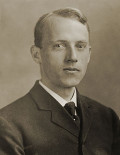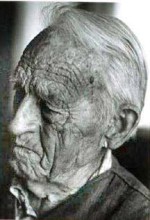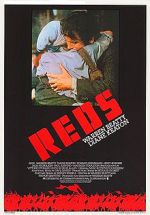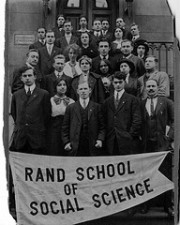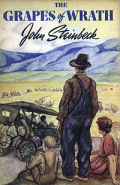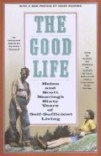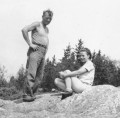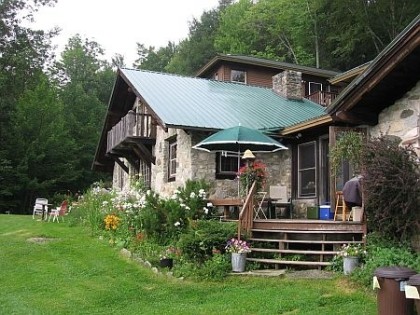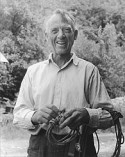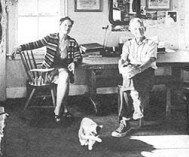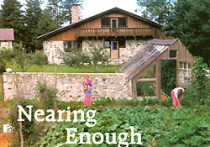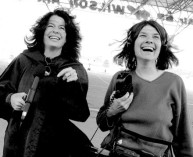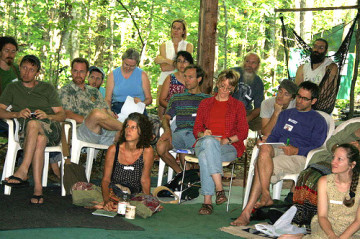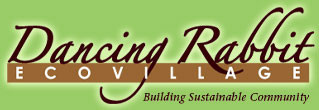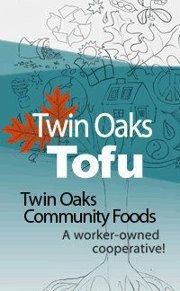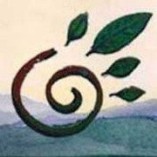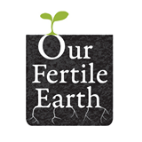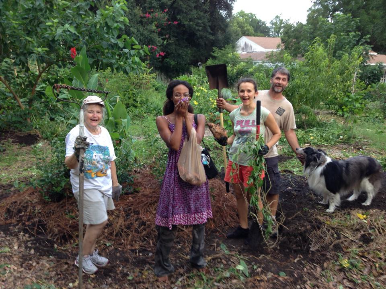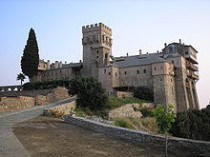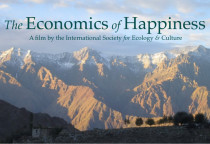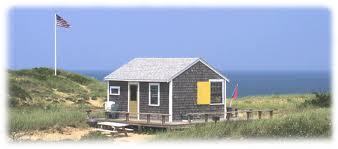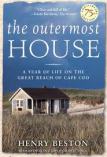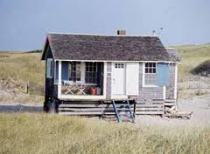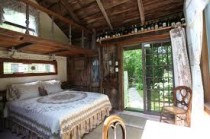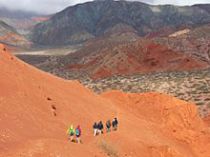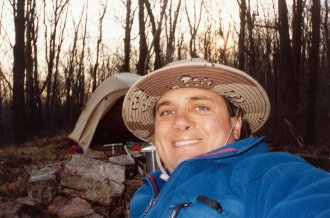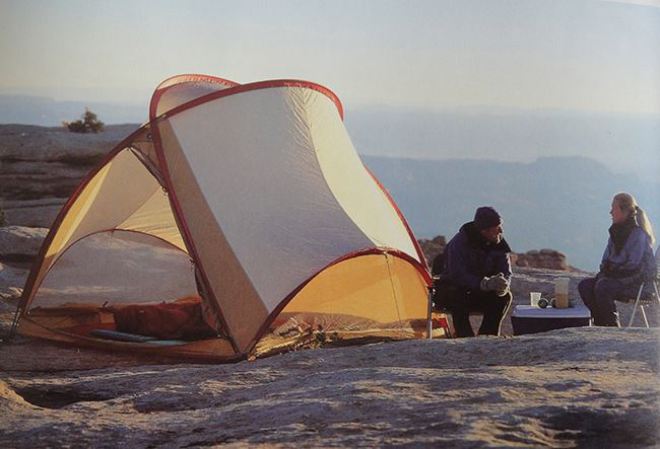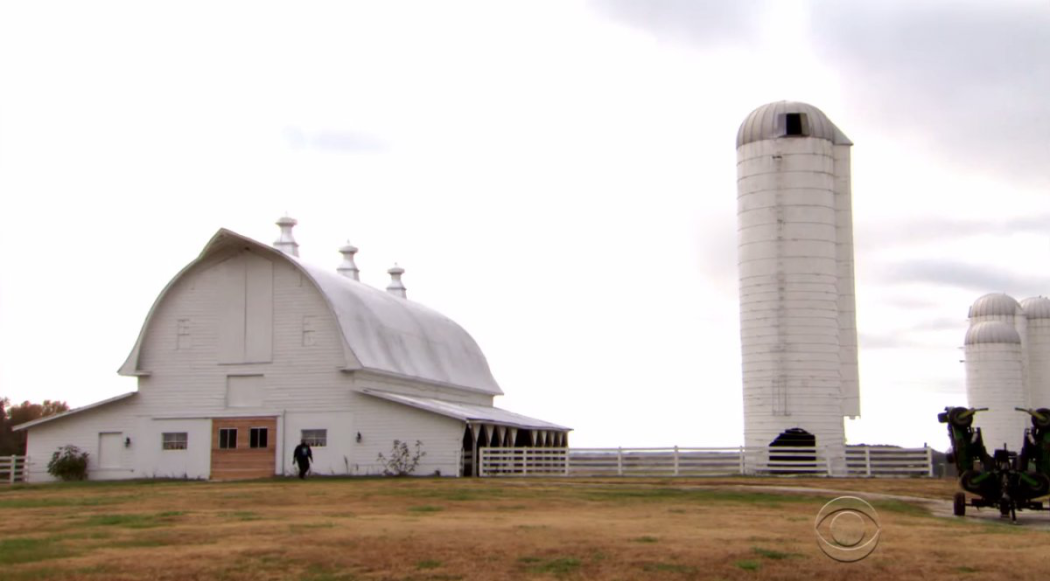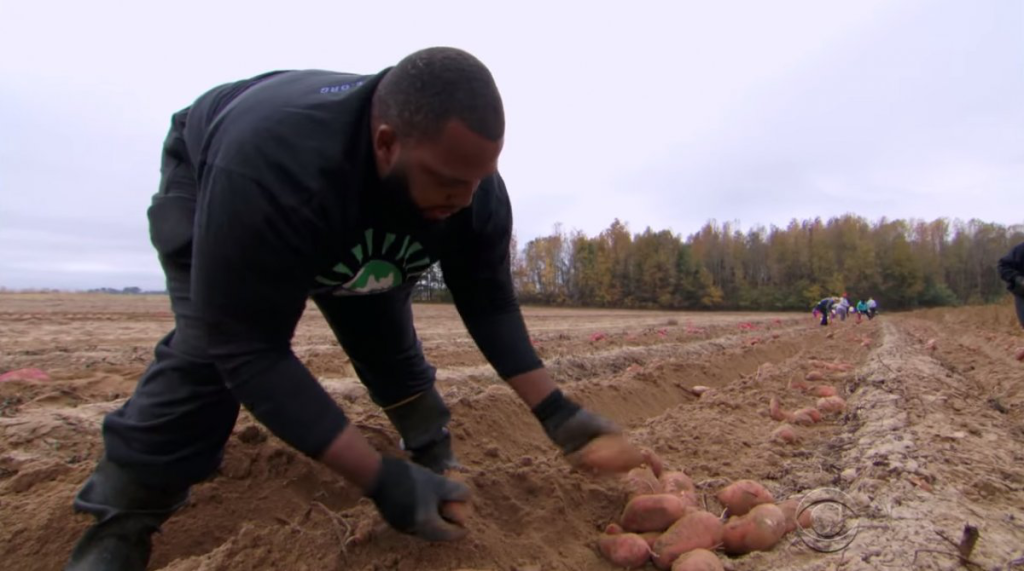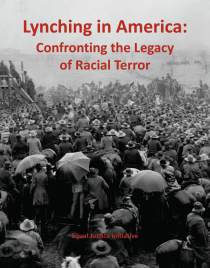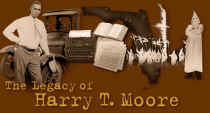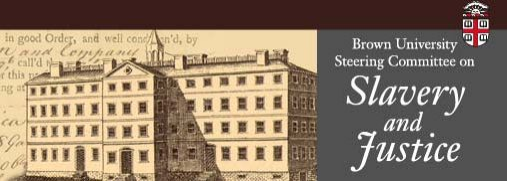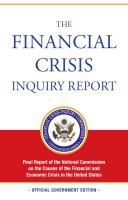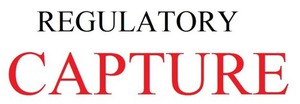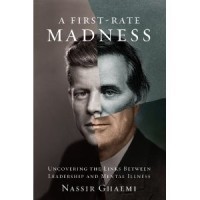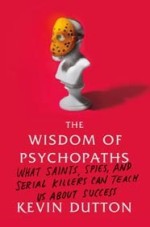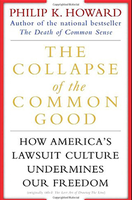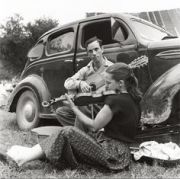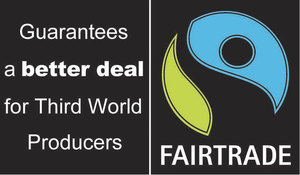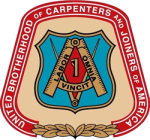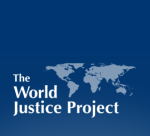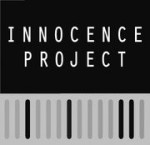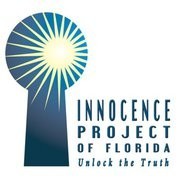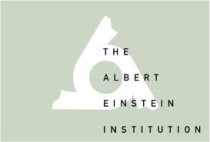The Good Life - Justice - Simple Living - Homesteading
Scott Nearing, Radical Wharton Professor
Selected passages from A Radical Who Laid the Groundwork for the
Tenure System
Scott Nearing was brilliant, without doubt, influencing generations over his century-long life by advocating what he believed to be a back-to-nature lifestyle of
economic and social purity. "If I am rich and you are poor," Nearing wrote, "both of us are corrupted by inequality."
Nearing…was influenced by Simon Nelson Patten, the great progressive economist and director of
Wharton School from 1896 to 1912. Nearing earned a doctorate in economics in 1909, began teaching sociology at Wharton, and became immersed in progressive social causes in Philadelphia.
Nearing opposed America’s involvement in World War I. In March 1918 he was indicted, but later exonerated by the federal government via the Espionage Act for his antiwar writing. In the 1920s he joined the Communist party until he was expelled from that organization
for being too radically independent.
Nearing later espoused a simple lifestyle of abstaining from products and economic practices that he believed hurt society. Among his 50 books was the classic Living the
Good Life, co-authored with his wife Helen in 1954 and republished in 1970, inspiring the countercultural movement of the time. Nearing died in 1983 shortly after his 100th birthday. full article
Wikipedia
Scott Nearing (1883-1983) was an American radical economist, educator, writer, political activist, and advocate of simple living.
Nearing was born in Morris Run, Tioga County, Pennsylvania, the heart of the
state's coal country…
...Nearing graduated from high school in 1901 and enrolled in the University of Pennsylvania Law School, "where corporate bias so violated his idealism that after one year he quit." Instead he studied oratory at Temple University in Philadelphia and enrolled in the Wharton School of Business of the University of Pennsylvania, where he immersed himself in the emerging science of economics. At the Wharton School, Nearing was deeply influenced by Simon Nelson Patten, an innovative and unconventional educator and founding father of the American Economic Association.[8]...
...Nearing distinguished himself as a "Wharton man" during the progressive era, one of the proverbial "best and brightest" trained in practical economics to be readied for a place as a responsible leader of the community.[9] In the words of another of his students, Patten taught innovative thinking—"making use of creative intelligence to master new situations irrespective of received dogma."[10] Nearing seems to have found these new intellectual tools for potential social change to be exciting and liberating. He completed his undergraduate program in just three years, while simultaneously engaging in campus politics and competitive debate.[8]
Nearing received his BS degree from the University of Pennsylvania in 1905 and his PhD in Economics in 1909. From 1905 to 1907, he served as the Secretary of the Pennsylvania Child Labor Committee, a volunteer society working to solve the child labor problem in the state.[11] From 1908 until 1915 while living in Arden, Delaware, Nearing taught economics and sociology at the Wharton School and Swarthmore College, authoring a stream of books on economics and social problems.[12]...Read more
Edmond Bordeaux Szekely, Deborah Szekely, Rancho La Puerta, The Golden Door, A Congressional Management Guide, Waiter, There’s a Guinea Pig in My Soup NY Times, Krishnamurti, Siempre Mejor! Krishnamurti Foundation, Krishnamurti Foundation America.
In 1917 Scott Nearing wrote ‘The Great Madness’ that blamed US involvement in WWI on J.P. Morgan bank and other corporate interests.
Sound familiar? Nearing's 1917 review of the ominous events from 1914 to 1917 that enabled the private interests of large corporations ("plutocracy") to propel the U.S. into World War I for their material profit, thereby permanently degrading and perverting U.S. democracy for the 20th century. Nearing’s analysis shows how the business class gained control of the inner workings of the United States government and were thus able to meld nationalist patriotism into a military preparedness which finally leads to an open declaration of war. Read more
- The Good Life Center, Scott & Helen Nearing's publications
- The Great Madness, by the Information Clearing House
- Scott Nearing biographical sketch by Ryan Eroh
- New England Historical Society, The Great Madness
- Counterpunch Scott Nearing on War
- Swarthmore College Scott Nearing Papers
- Chronological List of Books and Pamphlets by Scott Nearing
- Villanova University The Economics of Peace: World War I and Scott Nearing’s Radical America
The Rand School of Social Science
The Great Madness, Scott Nearing.pdf
Adobe Acrobat document [3.1 MB]
Scott Nearing appeared in the film Reds as a "witness"
Wikipedia
Reds is a 1981 epic drama film that was co-written, produced, and directed by Warren Beatty. The picture centers on the life and career of John Reed, the journalist and writer who chronicled the Russian Revolution in his book Ten Days That Shook the World. Beatty stars in the lead role alongside Diane Keaton as Louise Bryant and Jack Nicholson as Eugene O'Neill.
The supporting cast of the film includes Edward Herrmann, Jerzy Kosinski, Paul Sorvino, Maureen Stapleton, Gene Hackman, Ramon Bieri, Nicolas Coster and M. Emmet Walsh. The film also features, as "witnesses," interviews with the 98-year old radical educator and peace activist Scott Nearing (1883–1983), author Dorothy Frooks (1896–1997), reporter and author George Seldes (1890–1995), civil liberties advocate Roger Baldwin (1884–1981), and the American writer Henry Miller (1891–1980), among others. Read more
.
Rand School of Social Science
Wikipedia
The Rand School of Social Science was formed in New York City by adherents of the Socialist Party of America in 1906. The school aimed to provide a broad education to workers, imparting a politicizing class-consciousness, and additionally served as a research bureau, a publisher, and the operator of a summer camp for socialist and trade union activists.
The school changed its name to the "Tamiment Institute and Library" in 1935 and it was closely linked to the Social Democratic Federation after the 1936 split of the Socialist Party. Its collection became a key component of today's Tamiment Library and Robert F. Wagner Archives at New York University in 1963.
The Rand School of Social Science had no connection to the RAND Corporation, a non-profit global-policy think tank. Read more
Cunningham Memorial Library
Indiana State Library
Debs Collection
- The Great Madness: A Victory for the American Plutocracy. New York: Rand School of Social Science, 1917. 44 pp. Pamphlet N354 .G7 1917p.
- Scott Nearing's Address to the Jury: The Speach <Sic> Before the Jury When Charged with a Violation of the Espionage Act. New York: Rand School of Social Science, <1918>. 30 pp. Pamphlet N354 .S3 1918p.
- Nearing, Scott. Before the Court: Nearing-Debs New York: People's Print, <1919?> 22 pp. Pamphlet N354 .B4 1919p
- The New Slavery: Or, the World Made Safe for Plutocracy. Chicago: Socialist Party of the United States, 1920. 45 pp. Pamphlet N354 .N4 1920p.
Indiana State University Library, ISU Library Blog
Library’s Eugene Debs Collection Acquires New Letters
Wikipedia
The Grapes of Wrath is an American realist novel written by John Steinbeck and published in 1939. The book won the National Book Award[2] and Pulitzer Prize[3] for fiction, and it was cited prominently when Steinbeck was awarded the Nobel Prize in 1962.[4]
Set during the Great Depression, the novel focuses on the Joads, a poor family of tenant farmers driven from their Oklahoma home by drought, economic hardship, agricultural industry changes and bank foreclosures forcing tenant farmers out of work. Due to their nearly hopeless situation, and in part because they are trapped in the Dust Bowl, the Joads set out for California. Along with thousands of other "Okies", they sought jobs, land, dignity, and a future.
The Grapes of Wrath is frequently read in American high school and college literature classes due to its historical context and enduring legacy.[5][6] A celebrated Hollywood film version, starring Henry Fonda and directed by John Ford, was made in 1940. Read more
- The Big Read Review of The Grapes of Wrath, a program of the National Endowment for the Arts.
.
The Good Life: Helen and Scott Nearing's Sixty Years of Self-Sufficient Living. "Helen and Scott Nearing are the great-grandparents of the back-to-the-land movement, having abandoned the city in 1932 for a rural life based on self-reliance, good health, and a minimum of cash...Fascinating, timely, and wholly useful, a mix of the Nearings' challenging philosophy and expert counsel on practical skills."--Washington Post Book World. Read more
.
Living The Good Life
Directed by John Hoskyns-Abrahall
Produced by Bullfrog Films
A portrait of the daily life of America's most famous back-to-the-landers. Filmed in 1976.
Scott Nearing had nothing to do with the credit economy. Nearing did not borrow money, and he not pay interest. Instead Nearing preferred to "pay as we go". Nearing also
"wished the bankers would find useful occupations for themselves and let the economy alone". YouTube
Vermont Public Radio (podcast)
VT Edition: Modern Homesteading
Homesteading conjures images of a life of complete self-sufficiency: living off the grid and growing your own food. But there is no easy definition of the
practice and these days there are many different approaches.
VPR's Steve Zind talks with Rebecca Kneale Gould, Associate Professor of Religion at Middlebury College and author of "At Home in Nature: Modern Homesteading
and Spiritual Practice in America" and Philip Ackerman-Leist, Associate Professor of Environmental Studies at Green Mountain College about how we define modern homesteading and what draws people to
the lifestyle. Read more
VT Edition: Modern Homesteading
2009_1222_vteda.mp3
MP3 audio file [17.0 MB]
The Good Life Center a non-profit education center based out of the last hand-built home of Helen and Scott
Nearing, which is located at Forest Farm in Harborside (Brooksville), Maine on five acres of forested land overlooking Spirit Cove. The Good Life Center's purpose is perpetuate the goals,
philosophies, life and ways of the Nearings.
The Nearing were two of America's most inspirational practitioners of simple, frugal and purposeful living. In 1932, at the height of the Great Depression, Helen and
Scott Nearing moved from their small apartment in New York City to a dilapidated farmhouse on 65 acres in Vermont. For over 20 years, they created fertile, organic gardens, hand-crafted stone
buildings, and a practice of living simply and sustainably on the land. In 1952, they moved to the Maine coast, where they later built their last stone home.
Through their 60 years of living on the land in rural New England, their commitment to social and economic justice, their numerous books and articles, and the time they
shared with thousands of visitors to their homestead, the Nearings embodied a philosophy that has come to be recognized as a centerpiece of America's "Back to the Land" and "Simple Living"
movements. Read more
- The Good Life Center Book Shop
- Professor Nearing, International Vegetarian Union (IVU)
- Rebecca Lepkoff's Photos "Residents & Radicals" 1950 VT
Helen and Scott Nearing: Counterculture authors, speakers and farmers
Mother Earth News
September/October 1971
A Plowboy Interview with Helen and Scott Nearing, authors of Living the Good Life and The Maple Sugar Book.
Helen and Scott Nearing have been living today's counterculture for better than a generation. Almost four decades ago (in 1932), the couple "dropped out" to a
rockscrabble mountain farm in Vermont's Green Mountains where they spent the next 20 years rebuilding the soil, constructing solid homestead buildings from native stone; growing their own food,
heating with wood they cut by hand and co--authoring numerous books and magazine articles. Tick off any of the present's most "in" passions—women's lib, equal rights, organic gardening,
vegetarianism, radicalism, homesteading, subsistence farming, ecology—and you'll find that the Nearings have been doing instead of talking for 40 years.
.
Nearing Enough
Mother Earth News
by Lynn Karlin
October/November 2003
A reflection on the simple-living lessons offered by legendary homesteaders Helen and Scott Nearing, authors of Living the Good Life.
At ages 68 and 89, Helen and Scott began building these stone buildings and garden walls to make their last homestead, which is open to the public
today.
By candlelight and snuggled away under quilts in a cozy, slant-ceiling guest room one winter's night long ago, I read Helen and Scott Nearing's Living the Good Life,
which had been left on the bedside table for me by my host.
The Nearings wrote, "We maintain that a couple, of any age ... with a minimum of health, intelligence and capital, can adapt themselves to country living, learn its
crafts, overcome its difficulties, and build up a life pattern rich in simple values and productive of personal and social good."
Helen and Scott Nearing lived a self-sufficient life in the 1930s and '40s in Vermont and, later into the 1990s, in Maine, their principles always directing their
choices.
Still today, the Nearings' initial questions, dilemmas and fears are shared by many people who want to take their lives into their own hands and live in a simpler, less
routinized, more socially sensible manner, with sun, wind and rain on their faces and organic food in their bellies, while leaving far, far behind them highrises and fluorescent lights, suburbs and
office cubicles, processed air and food and water, the proverbial Joneses, and those ubiquitous racing rats equipped with cell phones and beepers. Read more
..........Intentional Community - Living The Good Life........
Intentional Community is an inclusive term for ecovillages, cohousing communities, residential land trusts, communes,
student co-ops, urban housing cooperatives, intentional living, alternative communities, cooperative living, and other projects where people strive together with a common vision.
This web site serves the growing communities' movement, providing resources for starting a community, finding a community home, living in community, and creating more
community in your life.
Intentional Community, Facebook
There's a Place
Sardonicky Guest Post
by Neil Gillespie
November 29, 2011
This post was inspired by Valerie, Anne, DreamsAmelia and others who commented on Karen’s post "The Nightmare Before Christmas".
Each of you expressed a fundamental theme of human existence, the need for shelter and community. Is it better to rent or buy a home? Is real neighborliness in person
with your actual neighbors the bedrock of society, or can an online "community" suffice? And how does all this fit into the larger world or work and family?
There is another way: You can have it all, in an intentional community. The following is
inspired by many people and ideas too numerous to mention here, so I’ll begin with one person, Scott Nearing. "If I am rich and you are poor," Nearing wrote, "both of us are corrupted by
inequality." Read more
There's No Place Like Here: Communal Living with Nikki Silva
While traveling to help promote Etsy as a sponsor of the Bay Area Maker Faire, I was fortunate enough to receive an invitation to visit the wondrous place that is La
Selva. After a beautiful sunlight-through-the-mist drive down the winding seaside road of Highway 1, I reached Watsonville, CA, and eventually La Selva, where Nikki Silva, a public radio producer
best known for her work as one half of the Kitchen Sisters, greeted me. Nikki led me through the communal home that she and eight others have built for themselves in over thirty years of hard toiling
work. Naturally we waited all day for a break in the fog so I could get a shot of the majestic view overlooking Monterey Bay. Read more
The Federation of Egalitarian Communities is a union of egalitarian communities which have joined together in our common struggle to create a lifestyle based on equality, cooperation, and harmony with the earth. Read more
Dancing Rabbit Ecovillage
Sustainable Community Living
Dancing Rabbit is an ecovillage and intentional community of about 50 people set amid the hills and prairies of rural northeastern Missouri. Our goal is to live
ecologically sustainable and socially rewarding lives, and to share the skills and ideas behind that lifestyle. Read more
About Dancing Rabbit Ecovillage
At Dancing Rabbit Ecovillage (DR), we understand how difficult it can be to live sustainably and responsibly within modern US culture. We believe that we can work to
build a healthy alternative-- a social structure that is both non-exploitative and vibrant. As our village grows, we see this ideal take shape more clearly every day: a diverse range of people living
ecologically sound lives in a community that truly serves as an example of positive human action within the natural world.
In 1997 the DR Land Trust (DRLT) purchased 280 acres in the rolling hills of northeastern Missouri. We are now 12 years deep into pioneering, constructing buildings
while planning and developing community structure. People's social and economic needs are met primarily on-site and locally, though a few support themselves doing web work or off-site consulting.
There is an ever-increasing emphasis on internal economy, including a lot of barter and a well-used internal currency. Eventually, we see 500-1,000 people living in our village, with businesses and
homes surrounding the village green. Read more
The Twin Oaks Community, in rural central Virginia
Frequency555.com visits Twin Oaks Community in rural central Virginia. The community consists of around 85
adult members and 15 children and has been in existence since 1967. The core values reflected in their way of life are cooperation, sharing, nonviolence, equality, and ecology. The community is
diverse in religious and spiritual beliefs and their governance style shares responsibility amongst the members, and includes management, planning and committee positions.
Twin Oaks members consider their life communistic; however, they own and operate several successful businesses on their property, including a tofu and soy food-making
operation, organic seed company, a book indexing service, and hammock-making business. Community members work 42 hours a week, split between income labor and the domestic labor we all have do at home
anyway, so really they work about 20 hours a week and share their income. Their unique system provides each member housing, food, healthcare, and some personal spending money. On YouTube
- Frequency555.com: Twin Oaks-Clementine
Twin Oaks Hammocks
www.TwinOaksStore.com
Twin Oaks Hammocks has been making hammocks in our rural Virginia facility since 1967. All of our hammocks are hand-crafted by members of Twin Oaks Community. We
stand behind the quality and durability of our hammocks with one of the industry's best warranties—and we repair damaged hammocks as well.
For customer service or to order by phone, please call toll-free: 1-800-688-8946. Contact us 24/7/365 using our webform.
Twin Oaks Community Foods
www.TwinOaksTofu.com
We happily make every ounce of Twin Oaks Community Foods products personally by hand. That’s why we can guarantee the quality of our Tofu, and why we’re so proud of it.
We don’t just keep watch as depressed hired workers process little white squares down a conveyor belt like in some industrial nightmare. Our personal care and attention makes a big difference in the
quality of your food. Twin Oaks Tofu is a healthy, ethically-produced organic food, NOT a mass-produced industrial product.
Made with locally grown, organic NON-GMO soybeans, our Tofu meets the high standards for the Organic Certification established by the USDA Quality Certification Service.
Yep, that’s the green ORGANIC seal. The only label you can trust to mean real, bonafide, authentic organic. No genetic modification, no chemicals, no preservatives… only natural, organic
ingredients.
All Twin Oaks Community Food products are made with fresh, chlorine-free, non-floridated artisan well water. And since tofu is about 70% water, that makes a big taste
difference. Read more
Twin Oaks Tofu Facebook
Twin Oaks is an intentional community in rural central Virginia, made up of around 85 adult members and 15 children. Since the community's beginning in 1967, our way of life has reflected our values of cooperation, sharing, nonviolence, equality, and ecology.
Earthhaven Ecovillage, near Asheville, North Carolina
Frequency555.com: Earthaven Ecovillage
John Shimkus and Dana Lagomarsino of Frequency555.com visit Earthaven Ecovillage. John actually spent the summer there one year as a work-exchange volunteer learning
about permaculture, earthen building, and the communal way of life. John even used the experience as a reference point for his Master's thesis.
Earthaven is nestled in the Black Mountains about 40 minutes outside of Asheville, North Carolina. It rests on approximately 320 acres of resource abundant land, with
flowing streams and natural spring water. The community is off the grid, creating its own energy through solar systems and a micro-hydroelectric generator.
Earthaven utilizes permaculture design principles to construct earthen houses and practice sustainable agriculture. There are edible and medicinal gardens all over the
community, as well as humanely raised livestock which are integrated into the living system as fertilizers and garbage composters, making use of their existence beyond just meat and dairy production.
Since 1995 the community has served as a model for truly sustainable living.
Through their consensus governance model, all members of Earthaven are welcome to participate in the governance process. This is radically different from traditional
majority-vote, allowing for everyone in the community to have a say in the future of their ecovillage.
Earthaven is not a commune, and members possess their own private funds. There are several small businesses on-site, and many members offer consulting and educational
services that help spread awareness about their lifestyle. However, the community does incorporate their own monetary unit, called the "leap," into their economic system. This allows community
members to trade goods and services amongst one another within the community. Someone, for example, could exchange a massage for some home-grown berries, or an hour of labor.
Permaculture Paradise: Val & Eli's Summer Abundance
Our Fertile Earth
1071 Edgewood Ave S
Jacksonville, FL 32205
We are building a network of beautiful, productive farm and garden sites in and around our home town, Jacksonville, Florida. We're using organic methods of farming to
heal the earth and grow healthful food and to create local jobs.
We take stewardship of available lands and we:
1. design and build agricultural ecologies on site
2. gather and empower local members to support the site
3. research, record, and share our knowledge with as many people as we can.
Coming soon: garden baskets with fresh produce from the gardens. Read more
Mont Saint-Michel - Normandy, France
Wikipedia
Le Mont-Saint-Michel (English: Saint Michael's Mount) is an island commune in Normandy, France. It is located about one kilometre (0.6 miles) off the country's northwestern coast, at the mouth of the Couesnon River near Avranches. 100 hectares (247 acres) in size, the island has a population of 44 (2009).[1]
The island has held strategic fortifications since ancient times and since the 8th century AD has been the seat of the monastery from which it draws its name. The structural composition of the town exemplifies the feudal society that constructed it: on top, God, the abbey and monastery; below, the great halls; then stores and housing; and at the bottom, outside the walls, houses for fishermen and farmers.
Its unique position — on an island just 600 metres from land — made it accessible at low tide to the many pilgrims to its abbey, but defensible as an incoming tide stranded, drove off, or drowned, would-be assailants. The Mont remained unconquered during the Hundred Years' War; a small garrison fended off a full attack by the English in 1433.[2] The reverse benefits of its natural defence were not lost on Louis XI, who turned the Mont into a prison. Thereafter the abbey began to be used more regularly as a jail during the Ancien Régime.
One of France's most recognizable landmarks, Mont Saint-Michel and its bay are part of the UNESCO list of World Heritage Sites[3] and more than 3 million people visit it each year.[4] Read more
_____________________________________________
OPINION: While watching a Rick Steves travel-Europe program, I was reminded that all those old monasteries
and castles are actually intentional communities. One that I visited many years ago, Mont Saint-Michel in Normandy, France, is described by Wikipedia as "a rocky tidal island and a commune". That
linked to another Wikipedia Communes of France.
In "How the Irish saved Western Civilization" author Thomas Cahill
described how Irish monks and scribes maintain the record of Western civilization by copying manuscripts of Greek and Latin writers, both pagan and Christian, while libraries and learning on the
European continent was being overrun by barbarians.
In this time of economic uncertainty and intellectual dishonesty, there may be a place for intentional communities in America, to serve a role similar to the monasteries
and castles of Europe, to save civilization from Corporatism, which is the new fascism promoted by much of the left and the
right.
Mount Athos - Macedonia, Greece
Wikipedia
Mount Athos is a mountain and peninsula in Macedonia, Greece. A World Heritage Site and
autonomous polity within the Hellenic Republic under the official name Autonomous Monastic State of the Holy Mountain (Greek: Aftonomi Monastiki Politia Agiou Orous), Mount Athos is home to 20 stauropegial Eastern Orthodox monasteries under the direct jurisdiction
of the Ecumenical Patriarch of Constantinople.
Mount Athos is commonly referred to as the "Holy Mountain" (Greek: Agion Oros) and the entity as the "Athonite State" (Greek: Athoniki Politia). In the Classical era, while the mountain was called Athos, the peninsula was known as Acté or Akté.
Mount Athos has been inhabited since the ancient times and is known for its nearly 1,800-year continuous Christian presence and its long historical monastic traditions, which date back to at least 800 A.D. and the Byzantine era. Today, over 2,000 monks from Greece and many other Eastern Orthodox countries, such as Romania, Moldova, Bulgaria, Serbia and Russia, live an ascetic life in Athos, isolated from the rest of the world. The Athonite monasteries feature a rich collection of well-preserved artifacts, rare books, ancient documents, and artworks of immense historical value.
Although Mount Athos is technically part of the European Union like the rest of Greece, the status of the Monastic State of the Holy Mountain, and the jurisdiction of the Athonite institutions, were expressly described and ratified upon admission of Greece to the European Community (precursor to the EU). The free movement of people and goods in its territory is prohibited, unless formal permission is granted by the Monastic State's authorities. more
Mt. Athos: A visit to the Holy Mountain
60 Minutes CBS News
April 21, 2011
(CBS News) On this Easter Sunday, we're going to take you to a place outside our world. It's not Mars or Venus but it might as well be. It's a remote peninsula in
northern Greece that millions believe to be the most sacred spot on Earth.
It's called Mount Athos and prayers have been offered there every day, with no interruption, for more than a thousand years. It was set aside by ancient emperors to be
the spiritual capital of Orthodox Christianity and has probably changed less over the centuries than any other inhabited place on the planet. The monks come to Mount Athos from all over and do
everything they can to keep what they call "the world" far away. Read more
- CBS-News, Mt. Athos, Part 2
- CBS-News, Extra: Mt. Athos' autonomy
Politics - Living the Good Life, Economics of Happiness
The Economics of Happiness
Economic globalization has led to a massive expansion in the scale and power of big business and banking. It has also worsened nearly every problem we face:
Fundamentalism and ethnic conflict; climate chaos and species extinction; financial instability and unemployment. There are personal costs too. For the majority of
people on the planet, life is becoming increasingly stressful. We have less time for friends and family and we face mounting pressures at work.
The Economics of Happiness describes a world moving simultaneously in two opposing directions. On the one hand, an unholy alliance of governments and big business
continues to promote globalization and the consolidation of corporate power. At the same time, people all over the world are resisting those policies, demanding a re-regulation of trade and
finance—and, far from the old institutions of power, they’re starting to forge a very different future. Communities are coming together to re-build more human scale, ecological economies based on a
new paradigm – an economics of localization. Read more
The Economics of Happiness, Facebook
Visit msnbc.com for breaking news, world news, and news about the economy
Alan Watts Official Website
Alan Watts was profoundly influenced by the East Indian philosophies of Vedanta and Buddhism, and by Taoist thought, which is reflected in Zen poetry and the arts of
China and Japan. After leaving the Church he never became a member of another organized religion, although he wrote and spoke extensively about Zen Buddhism, Hinduism, and Taoisim. Some
American Buddhists criticized him for not sitting regularly in zazen, even though he recorded several guided meditations teaching a variety of mediation techniques. Alan Watts responded simply by
saying: "A cat sits until it is done sitting, and then gets up, stretches, and walks away." Read more
Wikipedia
Alan Wilson Watts (6 January 1915 – 16 November 1973) was a British philosopher, writer, and speaker, best known as an interpreter and popularizer of Eastern philosophy for a Western audience. Born in
Chislehurst, England, he moved to the United States in 1938 and began Zen training in New York. Pursuing a career, he attended Seabury-Western Theological
Seminary, where he received a master's degree in theology. Watts became an Episcopal priest but left the ministry in 1950 and moved to California, where he joined the faculty of the American Academy of Asian
Studies.
Watts gained a large following in the San Francisco Bay Area while working as a
volunteer programmer at KPFA, a Pacifica Radio station in
Berkeley. Watts wrote more than 25 books and articles on subjects important to Eastern and Western religion, introducing the
then-burgeoning youth culture to The Way of Zen (1957), one of the first bestselling books on
Buddhism. In Psychotherapy East and West (1961), Watts proposed that Buddhism could be thought of as a form of psychotherapy and not just a religion. Like Aldous Huxley before him, he explored human consciousness in the
essay, "The New Alchemy" (1958), and in the book, The Joyous Cosmology (1962).
Towards the end of his life, he divided his time between a houseboat in Sausalito and a
cabin on Mount Tamalpais. Many of his books are now available in digital format and many of his recorded talks and lectures
are available on the Internet. According to the critic Erik Davis, his "writings and recorded talks still shimmer with a
profound and galvanizing lucidity."[2] more
The Henry Beston Society
Henry Beston's 1928 book, The Outermost House, is now considered a classic of American Literature and has a devoted following among its readers. Beston (1888-1968) wrote
the book after spending a solitary "year" in a 20x16 house on the dunes of Eastham on Cape Cod, using the house as a base while studying and observing the wonders of the elements in this glorious
maritime setting.
The Outermost House is considered to be one of the seminal works of today's environmental movements and "is one of the reasons that the Cape Cod National Seashore exists
today," in the words of the governor of Massachusetts, Endicott Peabody, in 1964. The governor's words were echoed by representatives of the National Park Service. Rachel Carson said it was the only book that ever influenced her writing. Read more
A Cape Cod Connection In 'The Outermost House'
National Public Radio
by Lucinda Fleeson
November 26, 2009
New England author Henry Beston helped me see the glory of a Cape winter in all its desolation and rawness. I had rented an old farmhouse in Truro for a month's writing
retreat and picked up a bunch of library books. I almost dismissed Beston's The Outermost House: A Year of Life on the Great Beach of Cape Cod. At first I thought it was just another chronicle of
escape to the countryside. But Beston's writing stirs our primal need for nature at its most wild and pure. He reminds us that we still live on an untamed planet. Read more
The Outermost House is a book by naturalist writer Henry Beston. It was published in 1928...[and] chronicles a season spent living on the dunes of Cape Cod. Wikipedia
Hiking the good life - joyful exercise for body and mind
Hiking
Wikipedia
Hiking is the preferred term, in Canada and the USA, for a long, vigorous walk, usually on trails (footpaths), in the countryside, while the word walking is used for shorter, particularly urban walks. On the other hand, in the United Kingdom, and the Republic of Ireland, the term walking is used to describe all forms of walking, whether it is a walk in the park or backpacking in the Alps. The word hiking is also sometimes used in the UK, along with rambling, hillwalking, and fell walking. In New Zealand a long, vigorous walk or hike is called tramping.[1] It is a popular activity with numerous hiking organizations worldwide, and studies suggest that all forms of walking have health benefits.[2][3] Read more
Appalachian Trail
Wikipedia
The Appalachian National Scenic Trail, generally known as the Appalachian Trail or simply the A.T., is a marked hiking trail in the eastern United States extending between Springer Mountain in Georgia and Mount Katahdin in Maine.[1] The trail is approximately 2,200 miles (3,500 km)[a] long, though the precise length changes over time as parts are modified or rerouted. The trail passes through the states of Georgia, North Carolina, Tennessee, Virginia, West Virginia, Maryland, Pennsylvania, New Jersey, New York, Connecticut, Massachusetts, Vermont, New Hampshire, and Maine. The path is maintained by 31 trail clubs and multiple partnerships,[2] and managed by the National Park Service, United States Forest Service, and the nonprofit Appalachian Trail Conservancy.[3][4] The majority of the trail is in forest or wild lands, although some portions traverse towns, roads and farms. The trail conservancy claims that the Appalachian Trail is the longest hiking-only trail in the world.[5]
The Appalachian Trail is famous for its many hikers, some of whom, called thru-hikers, attempt to hike it in its entirety in a single season. Others have managed to perform a "round-trip" of the trail where they thru-hike from one end to the other and then turn around to thru-hike the trail the other way, otherwise known as a "yo-yo". Many books, memoirs, web sites and fan organizations are dedicated to these pursuits.
An unofficial extension known as the International Appalachian Trail continues north into Canada and to the northern end of the Appalachian Mountain range, where it enters the Atlantic Ocean. Other unofficial extensions continue the southern end of the Appalachian range in Alabama and continue south into Florida, creating what is known as the Eastern Continental Trail.
The Appalachian Trail, the Continental Divide Trail, and the Pacific Crest Trail form what is known as the Triple Crown of long–distance hiking in the United States.[6][7] Read more
Bill Moss was born in 1923 in Detroit, Michigan, and showed his artistic talent at an early age. He studied art at the University of Michigan, the Layton School of Art, and the Cranbrook Academy of Art before getting a job as an artist for the Ford Times in 1949. In 1955 he designed the Pop-Tent, today widely credited with changing the world of camping. In 1960 he established his own design firm, C. William Moss Associates, in Ann Arbor, Michigan, and in 1975 he and Marilyn Moss co-founded Moss Tent Works in Camden, Maine, to design and produce innovative, high-performance camping tents, backyard and beach products, and architectural canopies. Bill left the company in 1983 and later worked as a painter and designer in Arizona until his death in 1994 at the age of 72. Read more
Bill Moss Tents Facebook
The Complete Walker
Wikipedia
The Complete Walker is an in-depth guide to backpacking, written by Colin Fletcher with illustrations by political aide/women's rights advocate Nick Bauer. It was very influential and "could be credited with starting the backpacking industry."[1] Since its first publishing in 1968, there have been three revised editions. The most recent edition, The Complete Walker IV, was co-authored by Chip Rawlins. More
___________________________________________________
Colin Fletcher
Wikipedia
Colin Fletcher (14 March 1922 – 12 June 2007) was a pioneering backpacker and writer.
In 1963, Fletcher walked the length of that portion of Grand Canyon contained within the 1963 boundaries of Grand Canyon National Park. Although his route spans only a little more than 1/3 the length of Grand Canyon, Fletcher was only the second person to complete this section and the first to accomplish the feat "in one go" — as chronicled in his bestselling 1968 memoir The Man Who Walked Through Time. Fletcher obtained the route information critical for successfully completing his epic trip from the godfather of Grand Canyon hiking, Harvey Butchart, who completed the distance barely ahead of Fletcher the same year — having hiked it one section at a time over 17 years. Through his influential hiker's guide, The Complete Walker, published the same year, he became a kind of "spiritual godfather" of the wilderness backpacking movement. Through successive editions, this book became the definitive work on the topic and was christened "the Hiker's Bible" by Field and Stream magazine. Read more
_________________________________________________
Colin Fletcher, 85, a Trailblazer of Modern Backpacking, Dies
The New York Times
By DENNIS HEVESI
Published: June 19, 2007
Colin Fletcher, whose ornate prose and prosaic tips on subjects like choosing the right hiking boots helped start the modern backpacking movement, died June 12 in Monterey, Calif. He was 85.
Mr. Fletcher died as a result of complications of head injuries he sustained in 2001 when he was struck by a car while walking near his home in Carmel Valley, Calif., said Chip Rawlins, who helped Mr. Fletcher write the fourth edition of "The Complete Walker" (Alfred A. Knopf, 2002). Many wilderness enthusiasts consider the work to be the hiker’s bible. Read more
Ex-NFL Player Jason Brown Who Made $25 Million Quit Football At Age 29 To Become A Farmer
Ex-NFL Player Who Made $25 Million Quit Football At Age 29 To Become A Farmer
Business Insider
By Tony Manfred
Nov. 19, 2014, 1:36 PM
In 2009, Jason Brown signed a five-year, $37.5 million contract with the St. Louis Rams that made him the highest-paid center in the NFL.
Five years later, after earning more than $25 million of that contract, Brown is a farmer who is helping to feed the hungry.
CBS News caught up with Brown in Louisburg, North Carolina, where he runs a 1,000-acre farm after learning how to grow crops on YouTube.
Brown was drafted 124th overall in 2005 and played nine seasons in the NFL before getting cut by the Rams in the spring of 2012.
At age 29, he still had plenty of NFL years ahead of him. He wasn't playing at the level he was in 2009, but his career was far from over. He had interest from numerous teams, including an offer from the Baltimore Ravens.
But he walked away from the game. The NFL world was surprised, and ESPN ran a story with the headline, "The Curious Case Of Jason Brown."
"My agent, he told me, 'You're making the biggest mistake of your life,'" Brown told CBS. "And I looked right back at him and I said, 'No I am not.'"
Brown is doing this to help the less fortunate. He grows sweet potatoes and other vegetables and donates his harvest to food pantries. According to the New & Observer, he has given away 46,000 pounds of sweet potatoes and 10,000 pounds of cucumbers this fall.
"When you see them pop up out of the ground, man it's the most beautiful thing you could ever see," he said of harvesting the sweet potatoes.
It does look pretty fun:
Brown went to school at the University of North Carolina. He had no idea how to farm back in 2012. He learned on YouTube.
It's a great story about life after football.
Watch the entire CBS report here

